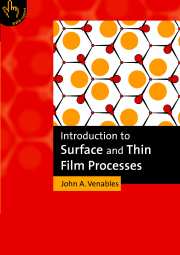Book contents
- Frontmatter
- Contents
- Preface
- Chapter 1 Introduction to surface processes
- Chapter 2 Surfaces in vacuum: ultra-high vacuum techniques and processes
- Chapter 3 Electron-based techniques for examining surface and thin film processes
- Chapter 4 Surface processes in adsorption
- Chapter 5 Surface processes in epitaxial growth
- Chapter 6 Electronic structure and emission processes at metallic surfaces
- Chapter 7 Semiconductor surfaces and interfaces
- Chapter 8 Surface processes in thin film devices
- Chapter 9 Postscript – where do we go from here?
- Appendix A Bibliography
- Appendix B List of acronyms
- Appendix C Units and conversion factors
- Appendix D Resources on the web or CD-ROM
- Appendix E Useful thermodynamic relationships
- Appendix F Conductances and pumping speeds, C and S
- Appendix G Materials for use in ultra-high vacuum
- Appendix H UHV component cleaning procedures
- Appendix J An outline of local density methods
- Appendix K An outline of tight binding models
- References
- Index
Chapter 9 - Postscript – where do we go from here?
Published online by Cambridge University Press: 06 July 2010
- Frontmatter
- Contents
- Preface
- Chapter 1 Introduction to surface processes
- Chapter 2 Surfaces in vacuum: ultra-high vacuum techniques and processes
- Chapter 3 Electron-based techniques for examining surface and thin film processes
- Chapter 4 Surface processes in adsorption
- Chapter 5 Surface processes in epitaxial growth
- Chapter 6 Electronic structure and emission processes at metallic surfaces
- Chapter 7 Semiconductor surfaces and interfaces
- Chapter 8 Surface processes in thin film devices
- Chapter 9 Postscript – where do we go from here?
- Appendix A Bibliography
- Appendix B List of acronyms
- Appendix C Units and conversion factors
- Appendix D Resources on the web or CD-ROM
- Appendix E Useful thermodynamic relationships
- Appendix F Conductances and pumping speeds, C and S
- Appendix G Materials for use in ultra-high vacuum
- Appendix H UHV component cleaning procedures
- Appendix J An outline of local density methods
- Appendix K An outline of tight binding models
- References
- Index
Summary
This short postscript wraps up the book, and provides pointers to further reading and gathering information. The comments are personal impressions rather than cut and dried issues. Please take them suitably lightly – and then get on with the rest of your life which is, of course, all too short. Time is the only real enemy – someone must have said that before.
Electromigration and other degradation effects in nanostructures
Degradation over time is an important part of materials science, and is inherent in the metastabilty of all artificially tailored structures. It is a major reason why I will have to replace the laptop computer, on which I have been composing this book, in the nottoo-distant future. There are many surface and thin-film related degradation processes involved, some of which have been discussed in the book, and some of which have been omitted for reasons of space and time. Others are being researched and could use a good review article. However, if I don't finish this book now, I never will (another example of degradation over time). I need to get on with other aspects of my life and so do you.
Polycrystalline metal wires forming interconnects can fail via necking of ‘bamboo’ structures, for the same basic reason as the tungsten filaments discussed in section 6.2.1. Such a wire has slight changes in thickness along its length, being slightly thinner where grain boundaries cross the wire, and slightly thicker either side (hence the name bamboo).
- Type
- Chapter
- Information
- Introduction to Surface and Thin Film Processes , pp. 297 - 302Publisher: Cambridge University PressPrint publication year: 2000



